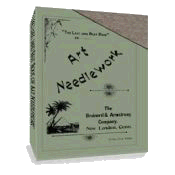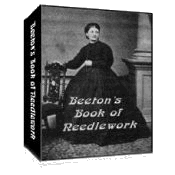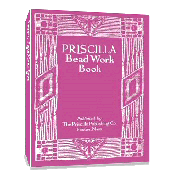[]Subscribe To This Site
Techniques for Folding Napkins Elegantly
The art of folding napkins into elegant shapes seems almost a lost art. Victorian ladies loved to add this kind of useful decoration to the table. If you love the look of elegantly folded napkins, here are some of the Victorian techniques (from 1862) you might want to try.
Folding Serviettes (Napkins)
To make them look well, or even to succeed in the more elaborate styles of folding, serviettes are required very fine, exactly square, not too large, to be starched, and folded quite damp, every fold creased in place with a clean hot iron. A box-iron is the best for this purpose, and it should be a small one, easily used.
The pantry or housekeeper's room is the place for folding the serviettes, which may then be brought to the table on a tray; but a lady may place a board covered with flannel on a small, light table, put the iron-stand upon it, and shift it down the outside of the dinner-table as she folds, so as to place each serviette as it is done on a plate.
A second iron must be heating to exchange with the one in use, for, unless very hot, the napkins will not be stiff enough. The shell and the Victoria Regia and the basket require them very stiff.
If at anytime the folding of a serviette is unsatisfactory, on no account attempt to refold the same : it is impossible to succeed with one already creased. Throw it aside to be re-damped or re-starched, which will take but a few moments, and meanwhile proceed with fresh ones.

Serviettes folded in alternate patterns down a table look well, such as mitres and shells, and there may be flowers placed in the shells. Figs. 32, 14, 4, and 5 — the mitre, the cornucopia, the pocket, and the shell — are perhaps the best of these designs.
The commoner kinds of folding can be achieved without the aid of starch, or even without an iron, although they look much better so assisted. The very simplest folds look extremely pretty if carefully done.
Serviettes should be spotlessly clean and glossy, and great nicety is required to fold them well. They are not folded after they have been used once; when for the family the same are likely to come to table again, a ring is placed beside each person, and the article rolled and slipped into it after use the first time, and brought to table again in the ring, the mark on the ring distinguishing the serviette of each person.
-

- One of the simplest styles is to fold the napkin in four, lengthways; then, like Fig. 1, keeping the whole of the fold at the top and the edges at A A and B B; roll up the ends at B to A, one at a time, as in Fig. 2, but roll them the reverse way to Fig. 2—that is, under, not over.

When both ends are rolled up as close as E, with a twist of the hand bring the ends of the rolls, D, to the point C, like Fig. 3. Then lay the part shown in Fig. 3 flat on the table, and set up the diamond-shaped fold at the top with the hands; slip the dinner roll or slice of bread into the hollow. Before the bread is put in. Fig. 4 represents the form of the folded serviette.
- This varies a little from No. 1 in appearance. First fold it four times, lengthways, and then like. Fig. 1, as already described, keeping the hemmed edges at A A and B B; then roll it up precisely like Fig. 2, the rolls as there shown, outside. When both are close as E, take the points of the rolls at E between the thumb and finger of each hand, and bring them together underneath at C. By this means the point C will stand perfectly upright.Press the whole properly into place.

The difference between No. 5 and No. 4 is this:
In Fig. 2, No. 4 is rolled under; No. 5, over.
In Fig. 3, the part where the fold meets, which is shown by Fig. 4, is under or next the rolls which form No. 5. To form No. 5 this fold is outside.
Fig. 5 displays the folds of No. 2. No. 5 stands more upright than No. 4, and is a little less simple in appearance.

- Crown Pattern. — This requires the damask to be very stiff. Halve and quarter it each way, like Fig. 6; bring all the corners very exactly to the centre, like Fig. 7; bring the four corners of Fig. 7 also to the centre, and smooth them at the crease; then form it into the crown by folding the corners at A A in Fig. 7, and slipping them into similar folds at B B, bringing the napkin round and upright in the form of a crown (Fig. 9).

- The Flower. — To make this way of folding resemble a flower, copy Fig. 6 and then Fig. 7; bring all the corners of Fig. 7 nearly, but not quite, to the centre for the second fold; finish it as before, and then curl up the four centre points, like Fig. 10.

- The Cornucopia looks very pretty down a long dinner-table. Fold the serviette in a half, lengthways; then fold it like Fig. 11, the hems at the broad end. Take the comers, A and B, bring them back again to the corner C, like Fig. 12.

Double Fig. 12 together down the centre. This represents Fig. 13. At D, in Fig. 13, three folds exist, two outer and one inner. Set Fig. 13 upright, over the dinner roll with three of these folds to one side. Shape it nicely, keeping the space from E to F close.

A flower at the point E has a very pretty effect, especially if it be a scarlet geranium, which contrasts well with the white damask, and gives a brighter look to the table. To carry out the idea of the cornucopia, a few flowers and leaves may be placed in the manner shown in Fig. 14, the stalks slipped under the edge, but must not be done too profusely.
When the serviettes are removed by the guests, the flowers will be taken away by the waiter on the plates, and can be transferred to the finger-bowls.

- The Cocked Hat is made by folding the serviette first in half one way, and then in half the other way and once more in half, lengthways, in the way illustrated by Figs. 15 and 16, the dotted lines showing in each diagram where the next fold is made. Then make a fold still lengthways, turning one one way and one the other, not quite to the top. This fold is shown by A A A A in Fig. 17.

The serviette is supposed, in this diagram, to be laid flat on the table, the dotted line in the centre marking the fold, which is shown in Fig. 18 by the line at B. The lines in Fig. 17, below, from A to A and A to A, are the folds to be made lengthways, not quite meeting thetop, with the hemmed edges upwards where the lines are marked.

The napkin is supposed to be doubled in half again in Fig. 18, with the hems outside at the line A, on each side of it; then fold as in Fig. 18, first one side and then the other, and iron down the crease; then partly unfold one side, as shown in the diagram Fig. 19, below.

The dotted lines mark the creases in the unfolded part, and C and C show how the piece marked C, in Fig. 18, is turned down. The piece raised is now folded down again, the dotted line, creased, passed over the other side, and the ends tucked in and creased down flat. The serviette now resembles Fig. 20.

Arch it nicely over the dinner roll, and put a spray of flowers at the top to resemble the feather in a cocked hat, in the manner shown in Fig. 21.

- The Basket. — Fold a serviette twice, like Figs. 15 and 16, once longways, and the second time across. This is to reduce its size. Fold the four points to the centre, like Fig. 7; turn it over on the other side, and again fold the four points to the centre; again turn it face downwards, and with the other side up, turn back the four corners, Fig. 22; fold it from A to B, Fig. 22, and C to D, both folds to be made keeping the part uppermost outwards.

Open the last fold from C to D, and bring the shoulder B to the shoulder D by a fold at the dotted line between E. Repeat the same fold as that at E aH round. The napkin will now stand on end as a basket, by standing it on its legs at E and the other three corners,and opening it back at F, in the way shown by Fig. 25.
Fill the spaces with a few flowers, or cut the roll in four, put a portion in each, and just a flower or two.

This pattern placed the reverse way on the plate also looks well, the dinner roll in the centre outside. Fig. 24; it requires the napkin to be very stiff, and exact in the folding. In Fig. 23 the bread is to be placed underneath.
- To fold a Serviette as a Dahlia. — Make it very stiff; fold the four corners to the centre as in Fig. 7. Repeat the process by folding the four corners now existing to the centre, and still repeat it a third time; form it round by pleating the edge, one pleat in the centre ofevery side, and one pleat to every corner.
When placed upright over the bread, the flower should open to the heart and display every petal.

- The Mitre is not difficult to fold, and always looks well. First fold the napkin in half; then fold down the corners as shown in Fig. 26; turn these corners down again, to meet in the middle, which is indicated by a dotted line. The napkin now looks like Fig. 27.

Fold this in half at the dotted line in the centre, bringing the two points back to back, for the fold is made outwards. Fig. 28 is the result. Fold over the two ends A and B, and produce Fig. 29. Let down the point C in Fig. 28, and fold the corners inside it; fold back C in its place again, turn the napkin over, and let down the point like C on the other side. The napkin now resembles Fig. 30.

Fold it down at the dotted lines, turning the points A and B towards C. Fig. 31 is the figure now represented. B is the point let down; turn it up again to E; slip the hand inside the hollow underneath the napkin, and shape the mitre nicely, and then place it over the dinner roll, like Fig. 32.
For more napkin folding techniques, see Napkin Folding Techniques, Pg. 2
_________________________
Return to top of Folding Napkins page.
Return to Victorian Christmas page.
Return to Home page.



 433 pages!
433 pages!

